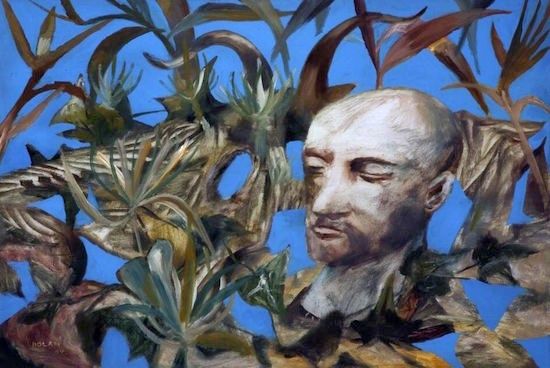

Death of a Poet, 1954
Sidney Nolan, Poet in a Landscape, 1941, private collection
Simon Martin is Director at Pallant House Gallery
"Sidney Nolan’s ‘Death of a Poet’ (1954) is an image that stays in the mind long after viewing it. Perhaps this is because of its dreamlike and even Surreal qualities. At first the image seems so serene: the cast of a head with its eyes closed, as if in sleep, seems to float in the air amidst foliage before an intense, cerulean sky. And yet, it depicts the death mask of the Australian bush ranger Ned Kelly, a hero/ anti-hero figure who obsessed Nolan. This depiction of Kelly is so unlike all the other images of him created by Nolan: the distinctive armoured helmet is absent and literally disembodied, Kelly is not presented with a heroic gait or in a dramatic moment from his infamous history. Instead we have the man at peace, no longer a threatening or heroic figure, but passive and introspective. The death mask has been on display in Melbourne since Kelly’s death, no doubt originally to provide conclusive evidence of his demise, but inevitably it has given life to the myth that surrounds him. Here it is presented like an archaeological fragment from an ancient civilisation found amongst the foliage, but in a way that also carries other resonant associations. As TG Rosenthal has stated it suggests images of Christ and the Crown of Thorns, but it also recalls the famous life mask of the British poet William Blake, and through its title perhaps relates to Arthur Rimbaud, whose poetry Nolan admired and whom he related to Kelly through their early deaths. The association with Blake’s life mask also brings us to Francis Bacon’s series of Studies for a Portrait after a life mask of Blake, which he began two months after this painting. It raises the question of whether Bacon had seen this painting. Nolan had settled in Britain in the previous year, and although the foliage is clearly based on Australian plant forms (which recall other paintings from the same year such as Australian Honeyeater and Australian Foliage, both 1954, Leicester County Council Artworks Collection), it suggests that he may have been influenced by paintings by British ‘Neo-Romantic’ artists of the 1940s and 50s, such as Graham Sutherland’s series of Thorn Trees and images of poets surrounded by foliage by John Craxton such as Dreamer in a Landscape (1941, Tate) and Poet in a Landscape (1941, private collection) which had been published in Horizon magazine in 1941."